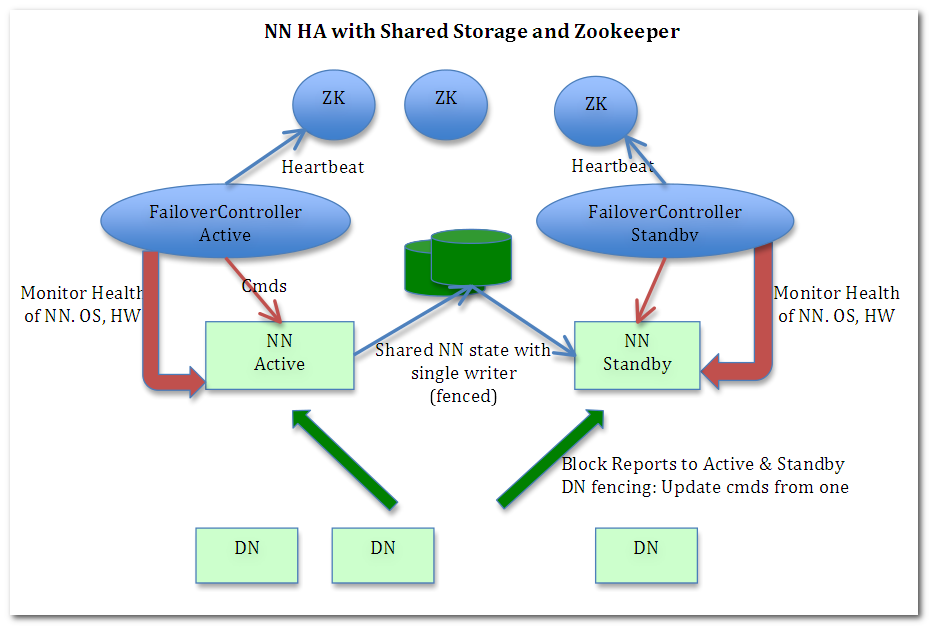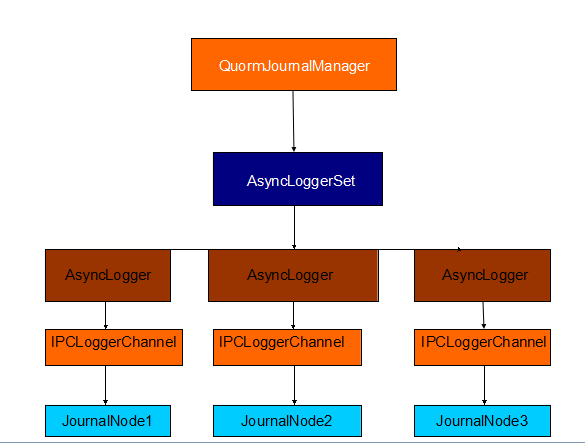前言
最近在排查公司Hadoop集群性能问题时,发现Hadoop集群整体处理速度非常缓慢,平时只需要跑几十分钟的任务时间一下子上张到了个把小时,起初怀疑是网络原因,后来证明的确是有一部分这块的原因,但是过了没几天,问题又重现了,这次就比较难定位问题了,后来分析hdfs请求日志和Ganglia的各项监控指标,发现namenode的挤压请求数持续比较大,说明namenode处理速度异常,然后进而分析出是因为写journalnode的editlog速度慢问题导致的,后来发现的确是journalnode的问题引起的,后来的原因是因为journalnode的editlog目录没创建,导致某台节点写edillog一直抛FileNotFoundException,所以在这里提醒大家一定要重视一些小角色,比如JournalNode.在问题排查期间,也对YARN的JournalNode相关部分的代码做了学习,下面是一下学习心得,可能有些地方分析有误,敬请谅解.
JournalNode
可能有些同学没有听说过JournalNode,只听过Hadoop的Datanode,Namenode,因为这个概念是在MR2也就是Yarn中新加的,journalNode的作用是存放EditLog的,在MR1中editlog是和fsimage存放在一起的然后SecondNamenode做定期合并,Yarn在这上面就不用SecondNamanode了.下面是目前的Yarn的架构图,重点关注一下JournalNode的角色.
上面在Active Namenode与StandBy Namenode之间的绿色区域就是JournalNode,当然数量不一定只有1个,作用相当于NFS共享文件系统.Active Namenode往里写editlog数据,StandBy再从里面读取数据进行同步.
QJM
下面从Yarn源码的角度分析一下JournalNode的机制,在配置中定义JournalNode节点的个数是可多个的,所以一定会存在一个类似管理者这样的角色存在,而这个管理者就是QJM,全程QuorumJournalManager.下面是QJM的变量定义:
/**
* A JournalManager that writes to a set of remote JournalNodes,
* requiring a quorum of nodes to ack each write.
* JournalManager可以写很多记录数据给多个远程JournalNode节点
*/
@InterfaceAudience.Private
public class QuorumJournalManager implements JournalManager {
static final Log LOG = LogFactory.getLog(QuorumJournalManager.class);
// Timeouts for which the QJM will wait for each of the following actions.
private final int startSegmentTimeoutMs;
private final int prepareRecoveryTimeoutMs;
private final int acceptRecoveryTimeoutMs;
private final int finalizeSegmentTimeoutMs;
private final int selectInputStreamsTimeoutMs;
private final int getJournalStateTimeoutMs;
private final int newEpochTimeoutMs;
private final int writeTxnsTimeoutMs;
// Since these don't occur during normal operation, we can
// use rather lengthy timeouts, and don't need to make them
// configurable.
private static final int FORMAT_TIMEOUT_MS = 60000;
private static final int HASDATA_TIMEOUT_MS = 60000;
private static final int CAN_ROLL_BACK_TIMEOUT_MS = 60000;
private static final int FINALIZE_TIMEOUT_MS = 60000;
private static final int PRE_UPGRADE_TIMEOUT_MS = 60000;
private static final int ROLL_BACK_TIMEOUT_MS = 60000;
private static final int UPGRADE_TIMEOUT_MS = 60000;
private static final int GET_JOURNAL_CTIME_TIMEOUT_MS = 60000;
private static final int DISCARD_SEGMENTS_TIMEOUT_MS = 60000;
private final Configuration conf;
private final URI uri;
private final NamespaceInfo nsInfo;
private boolean isActiveWriter;
//远程节点存在于AsyncLoggerSet集合中
private final AsyncLoggerSet loggers;
private int outputBufferCapacity = 512 * 1024;
private final URLConnectionFactory connectionFactory;static List<AsyncLogger> createLoggers(Configuration conf,
URI uri, NamespaceInfo nsInfo, AsyncLogger.Factory factory)
throws IOException {
List<AsyncLogger> ret = Lists.newArrayList();
List<InetSocketAddress> addrs = getLoggerAddresses(uri);
String jid = parseJournalId(uri);
for (InetSocketAddress addr : addrs) {
ret.add(factory.createLogger(conf, nsInfo, jid, addr));
}
return ret;
} QuorumJournalManager(Configuration conf,
URI uri, NamespaceInfo nsInfo,
AsyncLogger.Factory loggerFactory) throws IOException {
Preconditions.checkArgument(conf != null, "must be configured");
this.conf = conf;
this.uri = uri;
this.nsInfo = nsInfo;
this.loggers = new AsyncLoggerSet(createLoggers(loggerFactory));
.../**
* Wrapper around a set of Loggers, taking care of fanning out
* calls to the underlying loggers and constructing corresponding
* {@link QuorumCall} instances.
*/
class AsyncLoggerSet {
static final Log LOG = LogFactory.getLog(AsyncLoggerSet.class);
private final List<AsyncLogger> loggers;
private static final long INVALID_EPOCH = -1;
private long myEpoch = INVALID_EPOCH;
public AsyncLoggerSet(List<AsyncLogger> loggers) {
this.loggers = ImmutableList.copyOf(loggers);
}/**
* Channel to a remote JournalNode using Hadoop IPC.
* All of the calls are run on a separate thread, and return
* {@link ListenableFuture} instances to wait for their result.
* This allows calls to be bound together using the {@link QuorumCall}
* class.
*/
@InterfaceAudience.Private
public class IPCLoggerChannel implements AsyncLogger {
private final Configuration conf;
//JournalNode通信地址
protected final InetSocketAddress addr;
private QJournalProtocol proxy;
/**
* Executes tasks submitted to it serially, on a single thread, in FIFO order
* (generally used for write tasks that should not be reordered).
* 单线程串行操作线程池
*/
private final ListeningExecutorService singleThreadExecutor;
/**
* Executes tasks submitted to it in parallel with each other and with those
* submitted to singleThreadExecutor (generally used for read tasks that can
* be safely reordered and interleaved with writes).
* 并行操作线程池
*/
private final ListeningExecutorService parallelExecutor;
private long ipcSerial = 0;
private long epoch = -1;
private long committedTxId = HdfsConstants.INVALID_TXID;
private final String journalId;
private final NamespaceInfo nsInfo;
private URL httpServerURL;
//journalnode线程metric统计操作
private final IPCLoggerChannelMetrics metrics;...
/**
* The number of bytes of edits data still in the queue.
* 积压的editlog记录数
*/
private int queuedEditsSizeBytes = 0;
/**
* The highest txid that has been successfully logged on the remote JN.
* 最高位的事物Id数量
*/
private long highestAckedTxId = 0;
/**
* Nanotime of the last time we successfully journaled some edits
* to the remote node.
*/
private long lastAckNanos = 0;
/**
* Nanotime of the last time that committedTxId was update. Used
* to calculate the lag in terms of time, rather than just a number
* of txns.
*/
private long lastCommitNanos = 0;
/**
* The maximum number of bytes that can be pending in the queue.
* This keeps the writer from hitting OOME if one of the loggers
* starts responding really slowly. Eventually, the queue
* overflows and it starts to treat the logger as having errored.
*/
private final int queueSizeLimitBytes;
/**
* If this logger misses some edits, or restarts in the middle of
* a segment, the writer won't be able to write any more edits until
* the beginning of the next segment. Upon detecting this situation,
* the writer sets this flag to true to avoid sending useless RPCs.
* 非同步状态指标,判断JournalNode是否掉线
*/
private boolean outOfSync = false;
...开始执行记录写操作
@Override
public ListenableFuture<Void> startLogSegment(final long txid,
final int layoutVersion) {
return singleThreadExecutor.submit(new Callable<Void>() {
@Override
public Void call() throws IOException {
getProxy().startLogSegment(createReqInfo(), txid, layoutVersion);
synchronized (IPCLoggerChannel.this) {
if (outOfSync) {
outOfSync = false;
QuorumJournalManager.LOG.info(
"Restarting previously-stopped writes to " +
IPCLoggerChannel.this + " in segment starting at txid " +
txid);
}
}
return null;
}
});
}@Override
public ListenableFuture<Void> finalizeLogSegment(
final long startTxId, final long endTxId) {
return singleThreadExecutor.submit(new Callable<Void>() {
@Override
public Void call() throws IOException {
throwIfOutOfSync();
getProxy().finalizeLogSegment(createReqInfo(), startTxId, endTxId);
return null;
}
});
}@Override
public void finalizeLogSegment(long firstTxId, long lastTxId)
throws IOException {
QuorumCall<AsyncLogger,Void> q = loggers.finalizeLogSegment(
firstTxId, lastTxId);
loggers.waitForWriteQuorum(q, finalizeSegmentTimeoutMs,
String.format("finalizeLogSegment(%s-%s)", firstTxId, lastTxId));
}JournalNode和Journal
与服务端对应的客户端,对每个JournalNode进行操作执行的类是JournalNode/**
* The JournalNode is a daemon which allows namenodes using
* the QuorumJournalManager to log and retrieve edits stored
* remotely. It is a thin wrapper around a local edit log
* directory with the addition of facilities to participate
* in the quorum protocol.
*/
@InterfaceAudience.Private
public class JournalNode implements Tool, Configurable, JournalNodeMXBean {
public static final Log LOG = LogFactory.getLog(JournalNode.class);
private Configuration conf;
private JournalNodeRpcServer rpcServer;
private JournalNodeHttpServer httpServer;
private final Map<String, Journal> journalsById = Maps.newHashMap();
private ObjectName journalNodeInfoBeanName;
private String httpServerURI;
private File localDir;
static {
HdfsConfiguration.init();
}
/**
* When stopped, the daemon will exit with this code.
*/
private int resultCode = 0;...
public void discardSegments(String journalId, long startTxId)
throws IOException {
getOrCreateJournal(journalId).discardSegments(startTxId);
}
public void doPreUpgrade(String journalId) throws IOException {
getOrCreateJournal(journalId).doPreUpgrade();
}
public void doUpgrade(String journalId, StorageInfo sInfo) throws IOException {
getOrCreateJournal(journalId).doUpgrade(sInfo);
}
public void doFinalize(String journalId) throws IOException {
getOrCreateJournal(journalId).doFinalize();
}
...File[] journalDirs = localDir.listFiles(new FileFilter() {
@Override
public boolean accept(File file) {
return file.isDirectory();
}
});
for (File journalDir : journalDirs) {
String jid = journalDir.getName();
if (!status.containsKey(jid)) {
Map<String, String> jMap = new HashMap<String, String>();
jMap.put("Formatted", "true");
status.put(jid, jMap);
}
}/**
* Set up the given Configuration object to point to the set of JournalNodes
* in this cluster.
*/
public URI getQuorumJournalURI(String jid) {
List<String> addrs = Lists.newArrayList();
for (JNInfo info : nodes) {
addrs.add("127.0.0.1:" + info.ipcAddr.getPort());
}
String addrsVal = Joiner.on(";").join(addrs);
LOG.debug("Setting logger addresses to: " + addrsVal);
try {
return new URI("qjournal://" + addrsVal + "/" + jid);
} catch (URISyntaxException e) {
throw new AssertionError(e);
}
}<property>
<name>dfs.namenode.shared.edits.dir</name>
<value>qjournal://had1:8485;had2:8485;had3:8485/mycluster</value>
</property>/**
* Start a new segment at the given txid. The previous segment
* must have already been finalized.
*/
public synchronized void startLogSegment(RequestInfo reqInfo, long txid,
int layoutVersion) throws IOException {
assert fjm != null;
checkFormatted();
checkRequest(reqInfo);
if (curSegment != null) {
LOG.warn("Client is requesting a new log segment " + txid +
" though we are already writing " + curSegment + ". " +
"Aborting the current segment in order to begin the new one.");
// The writer may have lost a connection to us and is now
// re-connecting after the connection came back.
// We should abort our own old segment.
abortCurSegment();
}
// Paranoid sanity check: we should never overwrite a finalized log file.
// Additionally, if it's in-progress, it should have at most 1 transaction.
// This can happen if the writer crashes exactly at the start of a segment.
EditLogFile existing = fjm.getLogFile(txid);
if (existing != null) {
if (!existing.isInProgress()) {
throw new IllegalStateException("Already have a finalized segment " +
existing + " beginning at " + txid);
}
...全部代码的分析请点击链接https://github.com/linyiqun/hadoop-yarn,后续将会继续更新YARN其他方面的代码分析。
参考源代码
Apach-hadoop-2.7.1(hadoop-hdfs-project)

